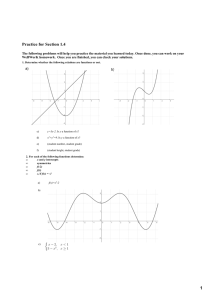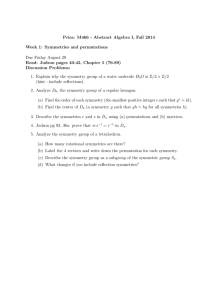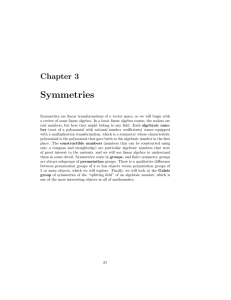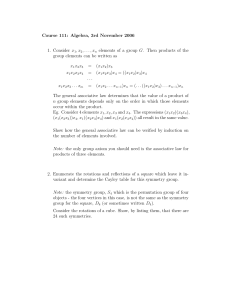An Efficient Way of Breaking Value Symmetries Jean-Franc¸ois Puget
advertisement
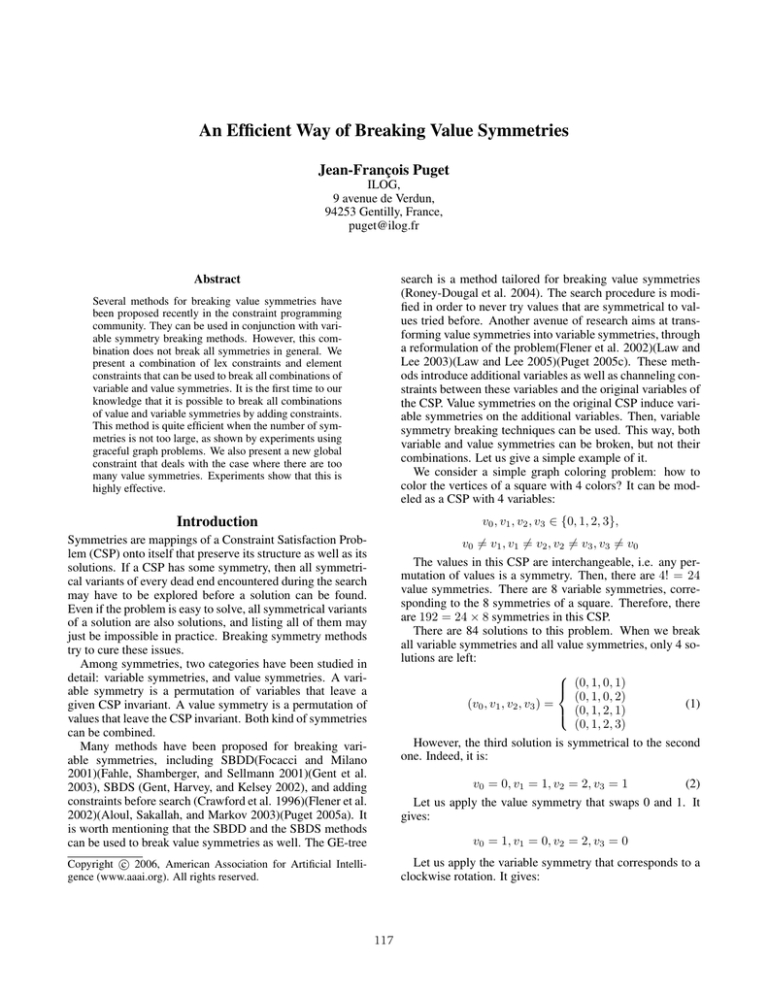
An Efficient Way of Breaking Value Symmetries
Jean-François Puget
ILOG,
9 avenue de Verdun,
94253 Gentilly, France,
puget@ilog.fr
Abstract
Several methods for breaking value symmetries have
been proposed recently in the constraint programming
community. They can be used in conjunction with variable symmetry breaking methods. However, this combination does not break all symmetries in general. We
present a combination of lex constraints and element
constraints that can be used to break all combinations of
variable and value symmetries. It is the first time to our
knowledge that it is possible to break all combinations
of value and variable symmetries by adding constraints.
This method is quite efficient when the number of symmetries is not too large, as shown by experiments using
graceful graph problems. We also present a new global
constraint that deals with the case where there are too
many value symmetries. Experiments show that this is
highly effective.
search is a method tailored for breaking value symmetries
(Roney-Dougal et al. 2004). The search procedure is modified in order to never try values that are symmetrical to values tried before. Another avenue of research aims at transforming value symmetries into variable symmetries, through
a reformulation of the problem(Flener et al. 2002)(Law and
Lee 2003)(Law and Lee 2005)(Puget 2005c). These methods introduce additional variables as well as channeling constraints between these variables and the original variables of
the CSP. Value symmetries on the original CSP induce variable symmetries on the additional variables. Then, variable
symmetry breaking techniques can be used. This way, both
variable and value symmetries can be broken, but not their
combinations. Let us give a simple example of it.
We consider a simple graph coloring problem: how to
color the vertices of a square with 4 colors? It can be modeled as a CSP with 4 variables:
Introduction
v0 , v1 , v2 , v3 ∈ {0, 1, 2, 3},
Symmetries are mappings of a Constraint Satisfaction Problem (CSP) onto itself that preserve its structure as well as its
solutions. If a CSP has some symmetry, then all symmetrical variants of every dead end encountered during the search
may have to be explored before a solution can be found.
Even if the problem is easy to solve, all symmetrical variants
of a solution are also solutions, and listing all of them may
just be impossible in practice. Breaking symmetry methods
try to cure these issues.
Among symmetries, two categories have been studied in
detail: variable symmetries, and value symmetries. A variable symmetry is a permutation of variables that leave a
given CSP invariant. A value symmetry is a permutation of
values that leave the CSP invariant. Both kind of symmetries
can be combined.
Many methods have been proposed for breaking variable symmetries, including SBDD(Focacci and Milano
2001)(Fahle, Shamberger, and Sellmann 2001)(Gent et al.
2003), SBDS (Gent, Harvey, and Kelsey 2002), and adding
constraints before search (Crawford et al. 1996)(Flener et al.
2002)(Aloul, Sakallah, and Markov 2003)(Puget 2005a). It
is worth mentioning that the SBDD and the SBDS methods
can be used to break value symmetries as well. The GE-tree
v0 = v1 , v1 = v2 , v2 = v3 , v3 = v0
The values in this CSP are interchangeable, i.e. any permutation of values is a symmetry. Then, there are 4! = 24
value symmetries. There are 8 variable symmetries, corresponding to the 8 symmetries of a square. Therefore, there
are 192 = 24 × 8 symmetries in this CSP.
There are 84 solutions to this problem. When we break
all variable symmetries and all value symmetries, only 4 solutions are left:
(0, 1, 0, 1)
(0, 1, 0, 2)
(v0 , v1 , v2 , v3 ) =
(1)
(0, 1, 2, 1)
(0, 1, 2, 3)
However, the third solution is symmetrical to the second
one. Indeed, it is:
c 2006, American Association for Artificial IntelliCopyright gence (www.aaai.org). All rights reserved.
Let us apply the variable symmetry that corresponds to a
clockwise rotation. It gives:
v0 = 0, v1 = 1, v2 = 2, v3 = 1
(2)
Let us apply the value symmetry that swaps 0 and 1. It
gives:
v0 = 1, v1 = 0, v2 = 2, v3 = 0
117
(y0 , y1 , . . . , yn−1 ), we say that X is lex smaller than Y (denoted X Y ) if and only if :
v1 = 0, v2 = 1, v3 = 0, v0 = 2
It is precisely the second solution.
As far as we know, the only published symmetry breaking methods able to remove the third solution are SBDS and
SBDD. The SSB method of (Sellmann and Van Hentenryck
2005) cannot be applied to this CSP because the variable
symmetries are too complex for that method. The GE-tree
method does not break any variable symmetry. The other
methods break separately value and variable symmetries, but
not all their combinations.
We present in this paper a set of symmetry breaking constraints that are able to remove all combinations of value and
variable symmetries. In the above example, the addition of
these constraints would leave only 3 solutions.
∀k ∈ I n , (x0 = y0 ∧ . . . ∧ xk−1 = yk−1 ) → xk ≤ yk (3)
Let us consider a solution (vi = ai )i∈I n of the CSP. Let
us consider the set of all solutions that are symmetric to it.
These solutions are (vi = ai )σi∈I n where σ ranges over the
group of symmetries of the CSP. Among all these solutions
there is one that is lexicographically smaller than the others.
This solution S satisfies the constraint:
∀σ ∈ G, S S σ
(4)
The above has been widely used for variable symmetries.
If σ is a permutation of variables that defines a symmetry,
then (4) is equivalent to the following constraint:
Symmetries, Graphs and CSPs
∀σ ∈ G, (v0 , v1 , . . . vn−1 ) (v0σ , v1σ , . . . , vn−1σ ) (5)
We denote the set of integers ranging from 0 to n − 1 by I n .
A constraint satisfaction problem P (CSP) with n variables is a triple P = (V, D, C) where V is a finite set of varin , and evables (vi )i∈I n , D a finite set of finite sets (Di )i∈I
ery constraint in C is a subset of the cross product i∈I n Di .
Without loss of generality, we can assume that Di ⊆ I k for
some k.
An assignment is a member of S, i.e. a vector of values
(ai )i∈I n such that ai ∈ Di for all i ∈ I n , and is denoted
(vi = ai )i∈I n . A partial assignment is sub vector of an
assignment.
A solution to (V, D, C) is an assignment that is consistent
with every member of C.
The symmetries we consider are permutations, i.e. one to
one mappings (bijections) from a finite set onto itself. Let
S n be the set of all permutations of the set I n . The image of
i by the permutation σ is denoted iσ . A permutation σ ∈ S n
is fully described by the vector [0σ , 1σ , . . . , (n − 1)σ ]. The
product of two permutations σ and θ is defined by i(σθ) =
(iσ )θ .
Given a permutation σ of I n , we define a variable permutation on (partial) assignments as follows:
This constraint can be easily enforced using a global constraint (Frisch et al. 2002)(Carlson and Beldiceanu 2002).
This global constraint has been used in various context, such
as in (Flener et al. 2002).
Lex leader Constraint for Value Symmetries
We want to enforce the constraint (4) when there are value
symmetries. In order to do so, we will use another global
constraint, the element constraint. This constraint is implemented in all major constraint programming systems.
An element constraint has the following form:
y = A[x]
where A = [a0 , a1 , . . . , ak−1 ] is an array of integers, x
and y are variables. The above element constraint is equivalent to:
y = ax ∧ x ∈ I k
i.e. it says that y is the x-th element of the array A. We
will only consider injective element constraints, where the
values appearing in the array A are pair wise distinct. In this
case, the operational semantics of the element constraint is
defined by the logical equivalence:
((vi = ai )i∈I n )σ = ((vi = aiσ )i∈I n )
Such permutation is called a variable symmetry if it maps
solutions to solutions.
Given a permutation θ of I k , we define a value permutation on (partial) assignments as follow:
∀i ∈ I k , x = i ↔ y = ai
((vi = ai )i∈I n )θ = ((vi = (ai )θ )i∈I n )
For the sake of clarity, we extend the element constraint to
sequences of variables. If X = (vi )i∈I n is a finite sequence
of variables, then we define A[X] as the application of an
element constraint to each element of the sequence:
Such permutation is called a value symmetry if it maps
solutions to solutions.
A[X] = (A[vi ])i∈I n
Lex Leader Solutions
Element constraints can be used to describe applications
of finite functions. For instance,
A very powerful symmetry breaking method has been
proposed in (Crawford et al. 1996). The idea is to
use a lexicographic order to compare solutions. Given
two finite sequences X = (x0 , x1 , . . . , xn−1 ) and Y =
y = 3x ∧ x ∈ I 4
is equivalently expressed through the following element
constraint:
118
(v0 , v1 , v2 , v3 ) A(01) [(v3 , v0 , v1 , v2 )]
y = A[x] ∧ A = [1, 3, 9, 27]
where A(01) = [1, 0, 2, 3]
Let us check that the solution (2) is not consistent with
this constraint. We replace the variables by their values in
the constraint. It gives:
The following observation is the basis for our new method
for breaking value symmetries: element constraint can also
be used to represent the effect of value symmetries.
Indeed, let θ be a value permutation corresponding to a
value symmetry. By definition, any assignment of a value a
to a variable x is transformed into the assignment of aθ to x:
(0, 1, 2, 1) A(01) [(1, 0, 1, 2)]
By definition of the element constraint on arrays, it is
equivalent to:
(x = a)θ = (x = aθ )
(0, 1, 2, 1) (A(01) [1], A(01) [0], A(01) [1], A(01) [2])
Let us consider xθ . The permutation θ is represented by
the array Aθ = [0θ , 1θ , . . . , (k − 1)θ ]. It defines a finite
function that maps a to aθ . The application of this function
to x can be expressed by Aθ [x]. Therefore, xθ = Aθ [x].
We have represented the effect of the value symmetry by an
element constraint.
More generally, if (a0 , a1 , . . . , an−1 ) is the sequence of
values taken by the variables V = (v0 , v1 , . . . , vn−1 ), then
(aθ0 , aθ1 , . . . , aθn−1 ) is the sequence of values taken by the
variables Aθ [V]. Therefore, S θ = Aθ [S] for all solutions S.
Let S be a lex leader solution. Then, S S θ . Using
the above, it means that S is a solution of the CSP with the
additional constraint:
By definition of A(01) it gives:
(0, 1, 2, 1) (0, 1, 0, 2)
It is false. Therefore, the solution (2) is pruned by the
constraint (7), and by extension, by the constraints (6).
This method requires M × N constraints when there are
M variables symmetries and N value symmetries. This
method will not scale well with the number of value symmetries. The next section describes a way to cope with a
large number of value symmetries.
A Global Constraint for Value Symmetries
V Aθ [V]
We present in this section a global constraint that can handle a large number of value symmetries. We assume that all
symmetries can be written as the composition σθ of a variable symmetry σ, and a value symmetry θ. Let us consider
all the constraints (6) for a given σ:
This constraint is the conjunction of n element constraints
and one lex constraint.
Let us go back to the example given in the introduction.
There is one value symmetry (01) that swaps 1 and 0. It
defines a finite function represented by the array A(01) =
[1, 0, 2, 3]. The following constraint removes the value symmetry:
∀θ, V Aθ [V σ ]
(8)
We have seen in the previous section how to enforce this
constraint with one constraint per value symmetry θ. We
now want to enforce using a single global constraint. In order to define such global constraint, let us first formalize tree
search.
We consider complete tree search methods. A variable is
selected at each non leaf node. Then, one branch is created
for every value in the domain of that variable. We identify a
node with the variable assignments that are true at the node.
Variables are listed in the order in which they have been assigned during search. Constraints can prune the tree: some
nodes are inconsistent. These nodes have no children. Solutions are leaves of the search tree that are not inconsistent.
Some constraint propagation algorithm may be applied at
every node. It may result in some assignment of variables.
In such case, we introduce a sequence of child node, one for
each assignment. Therefore, all the variables appear in the
path from the root node to a solution.
For instance, the tree search for the graph coloring example given in the introduction with the symmetry breaking
constraints described in the previous section is depicted in
Fig. 1. In the node v0 = 0, constraint propagation results
in v1 = 1. A node is created to represent this partial assignment.
Using (3), the constraint (8) is equivalent to the conjunction of the constraints for all k ∈ I n and for all θ:
V A(01) [V]
More generally, let us consider now the case where any
symmetry is the composition σθ of a variable permutation
σ and a value permutation θ. The variable permutation σ is
defined by a permutation of I n . The value permutation is
defined by a permutation of I k .
If (a0 , a1 , . . . , an−1 ) is the sequence of values
taken by the variables X = (v0 , v1 , . . . , vn−1 ), then
(aθ0σ , aθ1σ , . . . , aθ(n−1)σ ) is the sequence of values taken by
the variables Aθ [X σ ]. Therefore, S σθ = Aθ [S σ ] for all
solutions S.
Let S be a lex leader solution. Then, S S σθ . Therefore,
S is a solution of the CSP with the additional constraint:
V Aθ [V σ ]
(7)
(6)
This constraint is the conjunction of a permutation of the
variables, a lex constraint, and a global element constraint.
We can state these constraints for all symmetries.
In our graph coloring example, it gives 192 constraints.
Let us look at the symmetry made by a clockwise rotation
and a swap of values 0 and 1. The lex constraint for this
symmetry is:
119
Root
a0 = Aθ [a0σ ] ∧ a1 = Aθ [a1σ ]
v0=0
By definition of σ, it gives:
a0 = Aθ [a1 ] ∧ a1 = Aθ [a2 ]
v1=1
v2=2
v2=0
v3=1
Since a0 = 0, a1 = 1, and a2 = 2, it is equivalent to:
v3=2
(12)
0 = Aθ [1] ∧ 1 = Aθ [2]
Then, for each θ that satisfies (12), we must enforce:
v3=3
vk ≤ Aθ [vkσ ]
Figure 1: A tree search
i.e. we must enforce:
It is equivalent to:
2 ≤ Aθ [v3 ]
(v0 = Aθ [v0σ ]∧. . .∧vk−1 = Aθ [v(k−1)σ ]) → vk ≤ Aθ [vkσ ]
Formula (11) becomes:
We want to develop a forward checking algorithm for
these constraints. Assume that we reach a state Σ where
the first j variables have been instantiated with values
(a0 , a1 , . . . , aj−1 ). Let K be the smallest i such that vi or
viσ is not instantiated in Σ. Then, we can use the above constraint with any k such that k ≤ K. We replace the variables
by their values, which gives:
∀b ∃θ, 0 = Aθ [1] ∧ 1 = Aθ [2] ∧ 2 > Aθ [b] → v3 = b
The left had side conditions are true for b = 1 and for
b = 2. We can then remove both 1 and 2 from the domain
of v3 . It prunes the solution (2) that was discussed in the
introduction.
In order to implement our method, one need to efficiently
compute the value symmetries that satisfy (9). It can be done
using computational group theory algorithms (see (Seress
2003) for instance). We have implemented a special case
when any value permutation is a value symmetry. In this
case, it is easy to compute GσΣ from (9). Indeed, (9) is of the
form:
(a0 = Aθ [a0σ ]∧. . .∧ak−1 = Aθ [a(k−1)σ ]) → vk ≤ Aθ [vkσ ]
where aiσ is the value assigned to the variable viσ . If the
left hand side is not true, then, nothing can be done. If the
left hand side is true, then, θ is such that:
∀i ∈ I k , ai = Aθ [(aiσ )]
(9)
∀θ ∈ GσΣ , vk ≤ Aθ [vkσ ]
(10)
Aθ [b0 ] = c0 , . . . , Aθ [bk−1 ] = ck−1
(13)
Let C be the set of the ci that appear in (13), and let B be
the set of the bi that appear in (13). Then, the set of value
symmetries θ that are consistent with (13) are:
Let
be the set of value symmetries that satisfy (9).
Then, for any of those θ, we have to enforce the right hand
side:
GσΣ
∀i ∈ I k , Aθ [bi ] = ci
∀b ∈ I n − B, Aθ [b] ∈ I n − C
Then, (11) becomes:
It is simple to enforce. Let ak be the minimum value in
the domain of vk . Let b be a value in the domain of vkσ in
state Σ. If there exists θ ∈ GσΣ such that ak > Aθ [b], then b
should be removed from the domain of vkσ .
Therefore, in order to enforce (10), it is necessary to remove all the values b from the domain of vkσ such that
ak > Aθ [b]:
∀b ∃θ ∈ GσΣ , ak > Aθ [b] → vkσ = b
v2 ≤ Aθ [v3 ]
∀i ∈ I k ,
ak > ci
∀b ∈ I n − B, ak > min(I n − C)
(14)
→ vkσ =
bi
→ vkσ =
b
(15)
It is straightforward to implement.
It is worth looking at the case where σ is the identity. In
this case, the above reasoning can be simplified. First of all,
Gid
Σ is now the set of value symmetries θ such that:
(11)
It is not difficult to see that it is a sufficient condition as
well. Indeed, if it is enforced at each node, then, any solution
is a lex leader one. The proof is a mere application of the
definitions.
Let us see how it works in our graph coloring example.
We consider the variable symmetry σ defined by the permutation [1, 2, 3, 0]. Let us look at the node Σ = (v0 = 0, v1 =
1, v2 = 2). The smallest k such that either vk or vkσ is not
instantiated is 2. Indeed, v2σ is v3 which is not instantiated.
The set GσΣ is the set of all value symmetries θ such that:
∀i ∈ I k , ai = Aθ [ai ]
It is called the point wise stabilizer of (a0 , a1 , . . . , ak−1 ).
This set is denoted G(a0 ,a1 ,...,ak−1 ) . Then, condition (11) becomes simpler. We only have to remove from the domain of
vk all the values b such that there exists θ in G(a0 ,a1 ,...,ak−1 )
such that b > bθ . It is exactly the definition of the GE-tree
method of (Roney-Dougal et al. 2004).
120
Experimental Results
The variable symmetries are equivalent to the symmetries
of the dodecahedron. There are 120 of them. Curiously, the
authors of (Gent et al. 2003) overlooked half of the symmetries. These are obtained using the inversion through the
center of the dodecahedron. It makes the comparison somewhat awkward. Anyway, we provide some results in Table
3 for varying numbers of colors. It is worth noting that the
computer used in (Gent et al. 2003) is slightly slower (1
GHz) than ours (1.4 GHz).
We have implemented both the constraints (6), and the
global constraint that prunes values satisfying (11). Both
were implemented using ILOG Solver 6.2(ILOG SA. 2006).
All symmetries were computed with the method of (Puget
2005b). We considered several well known examples:
graceful graphs, n × n queen problem, and graph coloring.
Running times are measured on a Dell D800 laptop with a
1.4MHz Pentium M processor, running Windows XP.
Graceful graphs were studied in (Petrie and Smith 2003),
with updated results in (Petrie 2005). We have compared
the constraints of (6) (LEX) to the one of (Petrie 2005) and
to our previous work in (Puget 2005c). Table 1 gives the
number of solutions, the running time and the number of
backtrack for each of the three methods. The last example
in Table 1 is a simplified version of the K4×K3 example
where one edge value is set. Without this extra setting, the
problem was too difficult for the method of (Petrie 2005).
(Petrie 2005) uses ECLIPSE on a computer slightly faster
than our. Our method is much faster. We believe that a large
part of the difference comes from the difference in symmetry
breaking methods. Our approach is also better than the one
of (Puget 2005c). Indeed, this method does not break all
symmetries, as witnessed by the number of solutions found.
n
5
6
7
8
GE-tree
SOL
sec.
1
0.68
0
0.96
1
8.36
0
927.36
SOL
2
0
4
0
(Puget 2005c)
BT
sec.
0
0
5
0
271
0.11
23,794
4.27
SOL
1
0
1
0
LEX
BT
1
5
1
12,349
Colors
3
4
5
6
Sol
31
117,902
GAP-SBDD
BT
50
109,502
us
sec.
0.51
879
Sol
17
59, 027
7,826,402
174,936,085
BT
22
33,583
3,218,147
57,671,880
sec.
0
2.04
184
3583
Table 3. Results for finding all colorings of the Dodecahedron.
Our approach is much more scalable and efficient. Of
course, the difference of system (Eclipse vs. ILOG
SOLVER), and the fact that we take into account twice as
many symmetries as the others explains part of the difference. However, additional data provided in (Gent et al.
2003) show that 770 seconds were spent in the symmetry
handling code written in the highly efficient GAP system,
and only 109 seconds in Eclipse. The total running time for
our method is 5 time smaller than the time spent in handling
symmetry in the other method.
sec.
0
0
0.05
2.28
Conclusions
We have presented a new way of breaking value symmetries
in presence of variable symmetries. We have first shown
that any symmetry made out of a value symmetry and a variable symmetry could be broken by a combination of element
constraints and lex constraints. It is the first time to our
knowledge that it is possible to break all combinations of
value and variable symmetries by adding constraints. This
method is quite efficient when the number of symmetries is
not too large, as shown by experiments using graceful graph
problems. We have also derived a new global constraint that
deals with the case where there are too many value symmetries. We have shown how to propagate this global constraint
efficiently. We have also shown that our method can be related to the GE-tree method when there are no variable symmetries. Our experimental results prove that our approach is
significantly faster than any previously published method.
Our method requires to state one global constraint per
variable symmetry, regardless of the number of value symmetries. It remains to be seen if we can state less constraints
than the number of variable symmetries. It would be interesting to see if we can combine our work for instance with
the one of (Puget 2005a).
We have implemented our global constraint only for the
case where the value symmetry group is the group of all permutations. It would be interesting to implement it for general groups of symmetries. Such an implementation would
be similar to the GE-tree method. Indeed, one merely needs
to replace the use of stabilizers in the GE-tree method by the
sets of value symmetries that satisfy (11). In the meantime,
we can use the combination of lex and element constraints
to break any combination of value and variable symmetries.
Table 2. Results for finding all solutions to the n × n
queen problem.
Let us look at another difficult problem, namely the n × n
queen problem taken from (Kelsey, Linton, and RoneyDougal 2004). The problem is to color a n × n chessboard
with n colors, such that no line (row, column or diagonal)
contains the same color twice. This problem can be modeled with n2 variables, one per square of the chess board,
and one all different constraint per line. Any permutation
of the values is a symmetry. There are also 8 variable symmetries corresponding to the 8 symmetries of a square. We
compare our method with the GE-tree method(Kelsey, Linton, and Roney-Dougal 2004), and our method of (Puget
2005c). The GE-tree method could not be used alone, since
there are also some variable symmetries. Then, the authors
of (Kelsey, Linton, and Roney-Dougal 2004) have combined
GE-tree with the SBDD method. Results are shown in Table
2. First fail principle is used: the variable with the smallest
domain size is selected during search. It is worth noting that
the computer used in (Kelsey, Linton, and Roney-Dougal
2004) (2.4 GHz) is faster than ours (1.4 GHz)
As a last example, let us look at the dodecahedron coloring problem taken from(Gent et al. 2003). The problem is
to color the vertices of the dodecahedron with m colors so
that no edge has the same color at both ends. It is a standard
graph coloring example. We have compared our approach
with the GAP-SBDD method (Gent et al. 2003). It would be
interesting to compare our method to the methods of (Benhamou 2004) or (Ramani et al. 2004). Unfortunately, no
report on the use of these methods for this graph have been
published.
121
Graph
K3×P2
K4×P2
K5×P2
K6×P2
DW3
DW4
DW5
DW6
K3×K3
K4×K3
K4×K3(*)
Sol
4
15
1
(Petrie 2005)
BT
sec.
6
0.25
147
12.9
4,172
1356
0
44
1,216
48
1,053
33,622
1.95
36.1
1,609
0
1393
68
17
Sol
8
30
2
0
(Puget 2005a)
BT
83
1,863
53,266
1,326,585
38,000
sec.
0.01
0.27
6.5
305
Sol
4
15
1
0
0
44
1,216
35,877
0
22
17
LEX
BT
47
936
12,371
575,609
0
4,053
133,517
6,912,716
5,574
3,521,832
1,450,719
sec.
0.01
0.18
4.7
318
0
0.57
16.75
1,023
0.76
696
293
Table 1. Result for finding all graceful colorings.
Acknowledgements
Law, Y. C., and Lee, J. H. M. 2003. “Expressing Symmetry Breaking Constraints Using Multiple Viewpoints and
Channeling Constraints”. In Proceedings of SymCon 03
(held in conjunction with CP-2003), pages 127-141, 2003.
Law, Y. C., and Lee, J. H. M. 2005. “Breaking Value Symmetries in Matrix Models using Channeling Constraints”.
In Proceedings of the 20th Annual ACM Symposium on Applied Computing (SAC-2005), pages 375-380, 2005.
Petrie, K., Smith, B.M. 2003. “Symmetry breaking in
graceful graphs.” In Proceedings of CP’03, LNCS 2833,
930-934, Springer Verlag, 2003.
Petrie, K., Smith, B.M. 2005. ”Comparison of Symmetry Breaking Methods in Constraint Programming” In Proceedings of SymCon05, the 5th International Workshop on
Symmetry in Constraints, 2005
Puget, J.-F. 2005a. “Breaking symmetries in all different
problems”. In Proceedings of IJCAI 05, pages 272-277,
2005.
Puget, J.-F. 2005b. “Automatic detection of variable and
value symmetries” In Proceedings of CP 05, pages 475489, 2005.
Puget J.-F. 2005c. “Breaking All Value Symmetries in Surjection Problems” In Proceedings of CP 05, pages 490-504,
2005.
Ramani, A.; Aloul, F.A.; Markov, I.L.; Sakallah, K.A.
2004. “Breaking Instance-Independent Symmetries in Exact Graph Coloring.” In Proceedings of DATE 2004, pages
324-331.
Roney-Dougal, C.M.; Gent, I.P.; Kelsey, T.; Linton,
S. 2004. “Tractable symmetry breaking using restricted
search trees” In Proceedings of ECAI’04.
Sellmann, M., and Van Hentenryck, P. 2005. Structural
Symmetry Breaking In Proceedings of IJCAI 05.
Seress, A. 2003. Permutation Group Algorithms Cambrige
University Press, 2003.
The author would like to thank Marie Puget for her support
and her thorough proof reading.
References
Aloul, F.A.; Sakallah, K.A., and Markov, I.L. 2003. “Efficient Symmetry Breaking for Boolean Satisfiability.” In
Proceedings of IJCAI 2003, pages 271-276.
Benhamou, B., 2004. “Symmetry in Not-equals Binary
Constraint Networks”. In Proceedings of SymCon’04, pp.
2-8, Toronto, September 2004
Carlsson, M., and Beldiceanu, N. 2002. “Revisiting the
Lexicographic Ordering Constraint” SICS Technical report
T2002:17
Crawford, J.; Ginsberg, M.; and Luks E.M., Roy, A. 1996.
“Symmetry Breaking Predicates for Search Problems”. In
Proceedings of KR’96, pp. 148-159.
Fahle, T.; Shamberger, S.; and Sellmann, M. 2001. “Symmetry Breaking.” In Proceedings of CP01 (2001) 93-107.
Flener, P.;Frisch, A. M.; Hnich, B.; Kiziltan, Z.; Miguel,
I.; Pearson, J.; and Walsh, T. 2002. “Breaking Row and
Column Symmetries in Matrix Models”. In Proceedings of
CP’02, pp. 462-476, 2002
Focacci, F., and Milano, M. 2001. “Global Cut Framework for Removing Symmetries.” In Proceedings of CP’01
(2001) 75-92.
Frisch, A. M.; Hnich, B.; Kiziltan, Z.; Miguel, I.; and
Walsh, T. 2002. Global Constraints for Lexicographic Orderings. In Proceedings of CP’02, pp 93-108.
Gent, I.P.; and Harvey, W.; and Kelsey, T. 2002. “Groups
and Constraints: Symmetry Breaking During Search”. In
Proceedings of CP 2002, pp. 415-430.
Gent, I.P.; Harvey, W.; Kelsey, T.; and Linton, S. 2003.
“Generic SBDD Using Computational Group Theory”. In
Proceedings of CP 2003, pp. 333-437
ILOG SA. 2006. ILOG Solver 6.2. User Manual. ILOG,
S.A., Gentilly, France, January 2006.
Kelsey, T; Linton, SA.; and Roney-Dougal, CM 2004.
“New Developments in Symmetry Breaking in Search Using Computational Group Theory”. In Proceedings AISC
2004. Springer LNAI. 2004.
122

